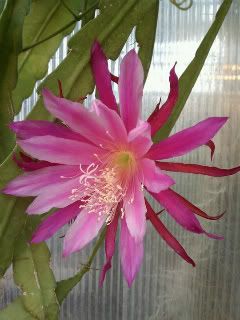
Epiphytes, such as these, are plants that grow without soil, often nestled within the branches of a tree. Debri that collects around the roots of the plant help to retain moisture and provide the nutrition the plant needs to grow and thrive. To recreate these conditions for an Orchid Cactus, you will need to modify its potting mix a bit. Standard potting soil is a bit too heavy and should be mixed with some additional perlite, though orchid bark, horticultural charcoal and coconut coir are also good.
Water your Orchid Cactus when the potting mix is almost completely dry. If the potting mix looks dry, lift the plant to test it's weight and dig in a finger a ways to feel for moisture. If you're not certain if it's dry enough to water, wait a day then check again. Try not to let the plant shrivel; that's a good indication its gone to long without water. Cut back watering dramatically during winter months. Established plants may not need any water at all, especially if given a cool place to rest such as a basement or garage. Temperatures should not go below 35 degrees Fahrenheit.
Propagation is typically done with cuttings, though hybridizing and propagation from seed can be fun for hobbyists. Cuttings should be allowed to callous over before they are placed in media, which takes about two weeks. Water cuttings very sparingly. To create a nice potted plant relatively quickly, I recommend placing several cuttings from the same plant together in a hanging basket.


